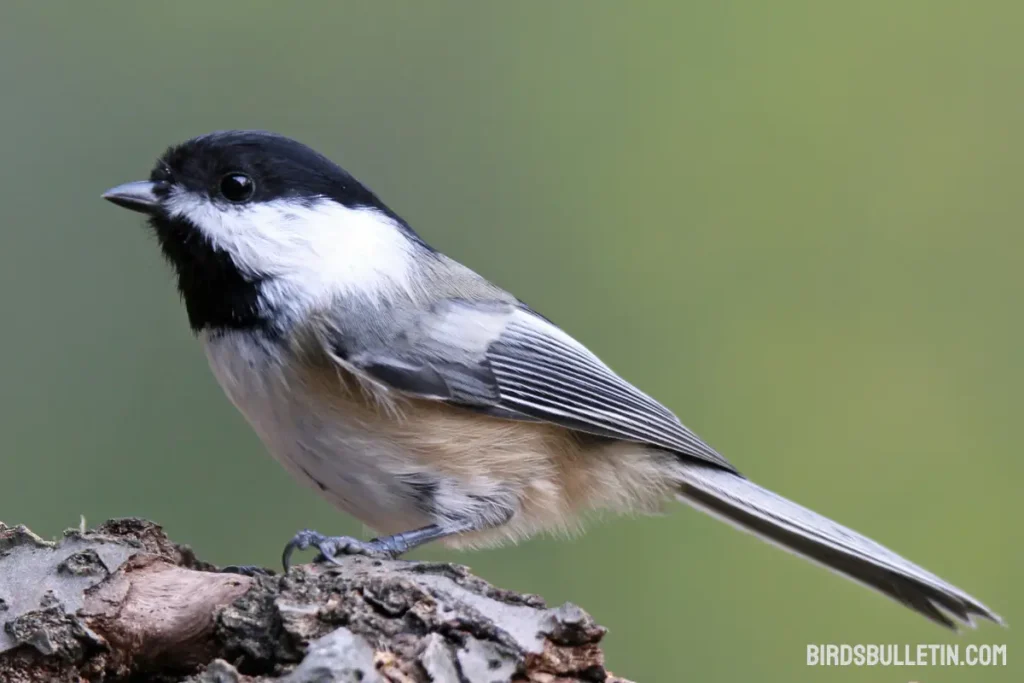Mexican Chickadee: Behaviors And More
With their distinctive nasal calls echoing through mountain woodlands, Mexican chickadees add vibrant sound and motion to their high-altitude habitats.
Read on to learn more about identifying these active songbirds along with details on their range, nesting, conservation status and more.
Want to learn more about Birds Overview
How To Identify The Mexican Chickadee?
Here are a few tips to help identify the Mexican chickadee:

Size and Shape: The Mexican chickadee is a small, round songbird, about 4-5 inches in length. It has a large rounded head in proportion to its body.
Color Pattern: It has gray upperparts, white undersides, and a black cap and bib (black markings on the head and chest). The wings and tail are gray with white edges.
Range: The Mexican chickadee is found in the southwestern United States and Mexico. Its range extends from southern Texas to central Mexico.
Behavior: It is active and acrobatic, constantly moving through trees and shrubs as it searches for insects and seeds. It may hang upside-down or hover while foraging.
Habitat: It inhabits dry open woodlands, scrublands, canyons, and riparian areas. It’s found in oak, pine-oak, and juniper forests within its range.
Distinguishing Features: Lacks the white wing patches found on other chickadee species. The black bib is wider than on the Carolina chickadee which overlaps part of its range. Song is faster paced than other chickadees.
Looking at the bird’s size, shape, color patterns, song, behavior, and range within Mexico and the southwestern US can help confirm the identification of a Mexican chickadee.
Mexican Chickadee Profile
| Information | Details |
|---|---|
| Scientific Name | Poecile sclateri |
| Alternative Names | Unknown |
| Color | Gray upperparts, white underparts, black cap and bib |
| Size | 4.3-5.1 in (11-13 cm) |
| Wingspan | 6.7-7.9 in (17-20 cm) |
| Weight | 0.25-0.39 oz (7-11 g) |
| Lifespan | 3-5 years, longest lifespan 10 years |
| Breeding Season | Mid-March to Mid-June |
| Lay Eggs | 5-8 eggs per clutch |
| Diet | Insects, spiders, seeds |
| Prey | Caterpillars, moths, beetles, ants |
| Threats and Predators | Hawks, falcons, owls, snakes |
| Locations | Southwestern US, Mexico |
Is The Mexican Chickadee A State Symbol?
The Mexican chickadee is not the official state bird or other state symbol of any Mexican state.
Its restricted range and more solitary nature mean it is less integrated into Mexican culture than chickadees in the United States and Canada.
How Many Subspecies Of Mexican Chickadee Exist?
The Mexican chickadee is considered a monotypic species by most modern taxonomic authorities, with no distinct subspecies recognized.
Upon further research, I found that the former subspecies classifications for this bird (P. s. sclateri, P. s. obscuratus, etc.) are no longer accepted in current ornithology.
Where Does The Mexican Chickadee Nest?
The Mexican chickadee nests in cavities in pine and pine-oak forests at elevations between 6,500-10,500 feet in the Transvolcanic Belt and Sierra Madre Occidental ranges of central Mexico.
Some details about their nesting habits:
- The Mexican chickadee (Poecile sclateri) is a small songbird found in central and northern Mexico.
- It nests in tree cavities, preferring old woodpecker holes and natural hollows in pine, oak and juniper trees. The nest is often lined with soft materials like fur, feathers, moss or grass.
- Mexican chickadees nest in both coniferous and deciduous forest habitats. They are found in pine-oak forests in mountainous areas up to around 10,000 feet in elevation.
- They also nest in tropical deciduous forests, thornscrub forest, and shade coffee plantations. The availability of suitable nesting cavities limits their distribution.
- Both the male and female participate in choosing the nest site. The female builds the nest and incubates the eggs alone, but both parents feed the hatchlings.
- The breeding season is generally from March to June. Mexican chickadees typically have one brood per year with clutches of 5-8 eggs.
What Is The Population And Status Of The Mexican Chickadee?
The Mexican chickadee has a relatively small population estimated between 50,000 to 400000 individuals. Its range covers about 164,000 square kilometers but is fragmented into isolated high elevation forests.
However, its population appears to be stable within this narrow range and niche. No major threats have been identified.
Does The Mexican Chickadee Migrate?
No, the Mexican chickadee does not undergo seasonal migrations. It is a year-round resident in its montane forest habitat, able to withstand the cooler high-elevation winters in Mexico through adaptations like cavity roosting and food caching.
Mexican chickadees may make small altitudinal movements up and down mountain slopes to track resources, but do not make long-distance migrations.
They are restricted to isolated highland forests separated by lowland valleys that form barriers to movement.
What Kind Of Behaviors Do Mexican Chickadees Exhibit?
The Mexican chickadee is not as social or flock-prone as other chickadees. But they do exhibit some classic chickadee behaviors:
Foraging – They search bark crevices and leaves for insects, spiders, seeds and berries. Their acrobatic movements and constant activity make them fun to watch.
Socializing – Mexican chickadees form flocks in winter for feeding and roosting. Their ‘chick-a-dee-dee’ call keeps the flock in contact.
Caching – This bird hide excess food in various sites and rely on memory to relocate caches throughout the year. This demonstrates intelligence.
Mobbing – When a potential threat is detected, Mexican chickadees will harass predators in a mob, diving and calling loudly.
Nesting – Using twigs and moss, females build nests in tree cavities or nest boxes provided by humans. Both parents feed the chicks.
Playing – They are known to playfully slide down branches or hang upside down.
Curiosity – Mexican chickadees are fearless and will readily investigate anything unusual. This makes them easy to attract for observation.
How Do Mexican Chickadees Interact With Humans?
Mexican chickadees are quite tame and interactive birds that readily approach humans. Their curiosity leads them to fearlessly investigate any human activities, and they become habituated to regular human presence.
They are common visitors at backyard bird feeders, perching on feeder poles or people’s hands to snatch up seeds. With patience, chickadees can be hand-fed sunflower seeds or suet from an outstretched palm. They quickly learn to associate humans with food.
Establishing a bond with individual chickadees is possible over time through routine positive interactions. Once trusted, these intelligent birds will eat from an open hand and even perch on fingers or heads.
What Is The Conservation Status Of The Mexican Chickadee?
The Mexican chickadee has a conservation status that is currently of least concern according to the IUCN Red List.
Its global population trend appears to be stable and it has a relatively widespread range throughout mountain forests of Mexico as well as some southwestern regions of the United States.
Its total population size has not been quantified but is estimated to number in the millions of individual birds.
Though the Mexican chickadee’s habitat is threatened in some areas by deforestation and development, the species adapts readily to human-altered environments such as parks and backyards.
Are There Any Laws Protecting Mexican Chickadees?
There are no specific laws or legal protections that apply to the Mexican chickadee. This is because its range is limited entirely to Mexico where it is considered a resident native species.
General Mexican environmental laws prohibit harming or capturing threatened and endangered species, but the chickadee has no special conservation status designation in Mexico currently. Responsible observation, research, and enjoyment of the species are encouraged.
Frequently Asked Questions
01. Why is the Mexican chickadee range so restricted?
Mexican chickadees evolved to live only in isolated high elevation pine-oak forests. They cannot survive in hot lowland areas surrounding these forest patches in central Mexico.
02. What is unique about Mexican chickadees?
They have different vocalizations, reduced social flocking behavior, and a patchy habitat compared to other chickadee species. Mexican chickadees also show lower genetic diversity.
03. Are Mexican chickadees rare?
No, Mexican chickadees have a small global population but can locally common within their narrowly endemic range in central Mexican mountain ranges.
Final Word
With a limited range and smaller total population, the Mexican chickadee warrants continued monitoring and habitat protection to maintain its genetic diversity and resilience. But this endemic bird remains little-studied compared to more widespread chickadees.
Responsible ecotourism, research, and public environmental education can further conservation for this species into the future. There remains opportunity to better understand the ecology and significance of the Mexican chickadee as the only chickadee to inhabit the pine-oak forests of Mexico’s scenic alpine central ranges.
References
- Birds of the World, Cornell Lab of Ornithology. Mexican chickadee. https://birdsoftheworld.org/bow/species/mexchi/cur/introduction
- IUCN Red List of Threatened Species. Poecile sclateri. https://www.iucnredlist.org/species/22735941/131925739







